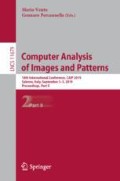Abstract
Genus zero surfaces are widespread forms in real life. It is important to have adequate mathematical tools that best represent them. Spherical harmonics are special bases able to model them in a compact and a relevant way. The main problem of the spherical harmonics modeling process is how to define the optimal reconstruction order that best represent the initial surface. This paper proposed a new spherical harmonics shannon-type entropy to optimize reconstruction and to provide an accurate and efficient evaluation method of the reconstruction order.
Access this chapter
Tax calculation will be finalised at checkout
Purchases are for personal use only
References
Telesca, L., Lapenna, V., Lovallo, M.: Information entropy analysis of seismcity of umbria-marche region (Central Italy). Nat. Hazards Earth Syst. Sci. 4(5/6), 691–695 (2004)
Telesca, L., Lovallo, M., Molist, J.M., Moreno, C.L., Mendelez, R.A.: Using the fisher-shannon method to characterize continuous seismic signal during volcanic eruptions: application to 20112012 El Hierro (Canary Islands) eruption. Terra Nova. 26, 425–429 (2014)
Wanga, B., Chena, L.L., Chengc, J.: New result on maximum entropy threshold image segmentation based on P system. Optik 163, 81–85 (2018)
Nicolis, O., Mateu, J.: 2D anisotropic wavelet entropy with an application to earthquakes in Chile. Entropy 17(6), 4155–4172 (2015)
Vazquez, P.-P., Feixas, M., Sebert, M., Heidrich, W.: Viewpoint Selection using Viewpoint Entropy, pp. 21–23. Stuttgart, Germany (2001)
Shannon, C.: A mathematical theory of communication. Bell Syst. Tech. J. 27, 379–423 (2008)
Khelifa, W.B., Ben Abdallah, A., Ghorbel, F.: Three dimensional modeling of the left ventricle of the heart using spherical harmonic analysis. In: ISBI, pp. 1275–1278 (2008)
Arfaoui S., Rezgui, I., Ben Mabrouk, A.: Wavelet Analysis On The Sphere, Spheroidal Wavelets, Degryuter. Degruyter, ISBN 978-3-11-048188-4 (2017)
Jallouli, M., Zemni, M., Ben Mabrouk, A., Mahjoub, M.A.: Toward recursive spherical harmonics-issued bi-filters: Part I: theoretical framework. Soft Computing. Springer, Berlin (2018). https://doi.org/10.1007/s00500-018-3596-9
Muller, I.: Entropy and energy, a universal competition. Entropy 10, 462–476 (2008)
Robinson, D.W.: Entropy and uncertainty. Entropy 10, 493–506 (2008)
Muller, I.: Extended thermodynamics: a theory of symmetric hyperbolic field equations. Entropy 10, 477–492 (2008)
Ruggeri, T.: The entropy principle from continuum mechanics to hyperbolic systems of balance laws: the modern theory of extended thermodynamics. Entropy 10, 319–333 (2008)
Fradkov, A.: Speed-gradient entropy principle for nonstationary processes. Entropy 10, 757–764 (2008)
Sello, S.: Wavelet entropy and the multi-peaked structure of solar cycle maximum. New Astron. 8, 105–117 (2003)
Brechbuhler, C., Gerig, G., Kubler, O.: Parametrization of closed surfaces for 3-D shape description. Comput. Vis. Image Underst. 16, 154–170 (1996)
Chen, C., Huang, T.: Left ventricle motion analysis by hierarchical decomposition. ICASSP 3, 273–376 (1992)
Staib, L.H., Duncan, J.S.: Model-based deformable surface finding for medical imaging. IEEE Trans. Med. Imag. 15, 720–731 (1996)
Ibrahim Mahmoud, M.M., Ben Mabrouk, A., Abdallah Hashim, M.H.: Wavelet multifractal models for transmembrane proteins’ series. Int. J. Wavelets Multires. Inf. Process. 14, 1650044 (2016)
Makadia, A., Daniilidis, K.: Direct 3D-rotation estimation from spherical images via a generalized shift theorem. In: IEEE Computer Society Conference on Computer Vision and Pattern Recognition, Proceedings, pp. 18–20 (2003)
Author information
Authors and Affiliations
Corresponding author
Editor information
Editors and Affiliations
Rights and permissions
Copyright information
© 2019 Springer Nature Switzerland AG
About this paper
Cite this paper
Jallouli, M., Khalifa, W.B., Mabrouk, A.B., Mahjoub, M.A. (2019). Toward New Spherical Harmonic Shannon Entropy for Surface Modeling. In: Vento, M., Percannella, G. (eds) Computer Analysis of Images and Patterns. CAIP 2019. Lecture Notes in Computer Science(), vol 11679. Springer, Cham. https://doi.org/10.1007/978-3-030-29891-3_4
Download citation
DOI: https://doi.org/10.1007/978-3-030-29891-3_4
Published:
Publisher Name: Springer, Cham
Print ISBN: 978-3-030-29890-6
Online ISBN: 978-3-030-29891-3
eBook Packages: Computer ScienceComputer Science (R0)

